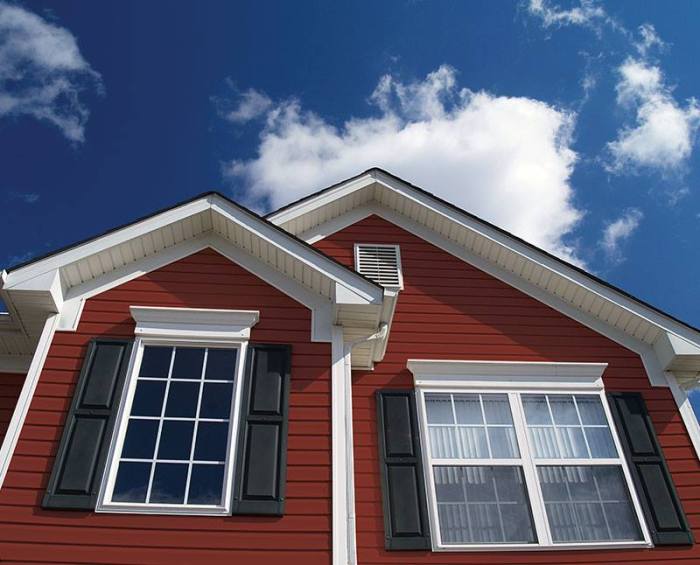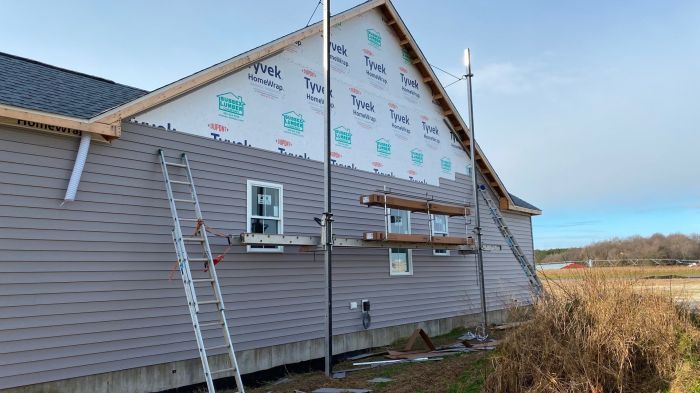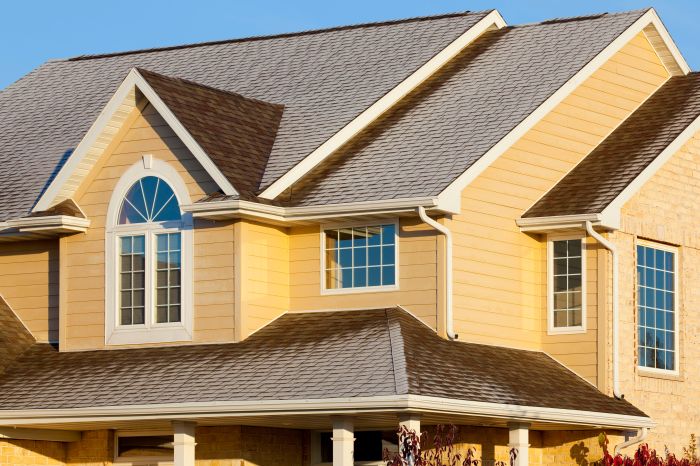Benefits of Insulated Siding: A Homeowners Delight. Upgrading your home’s exterior isn’t just about aesthetics; it’s about investing in comfort, energy efficiency, and long-term value. This article dives deep into the numerous advantages of choosing insulated siding, from significant cost savings on energy bills to enhanced curb appeal and a quieter, more comfortable living environment. We’ll explore everything from the installation process to the environmental benefits, painting a clear picture of why insulated siding is a smart choice for homeowners.
We’ll examine how insulated siding dramatically reduces energy consumption, leading to lower utility bills and a smaller carbon footprint. We’ll also delve into its durability and low-maintenance aspects, comparing it to traditional siding options. Finally, we’ll showcase how insulated siding enhances your home’s aesthetic appeal, potentially boosting its market value. Get ready to discover why insulated siding is the ultimate home improvement upgrade!
Enhanced Comfort and Indoor Climate Control

Insulated siding significantly improves your home’s comfort by acting as a barrier against external temperature fluctuations. This means a more stable indoor climate, regardless of the weather raging outside. The result? A consistently comfortable living space, year-round.Insulated siding minimizes temperature swings by preventing heat loss in winter and heat gain in summer. This is achieved through the insulating material within the siding itself, which acts as a buffer against the outside elements.
Unlike traditional siding, which offers little to no insulation, insulated siding actively contributes to maintaining a more consistent internal temperature. This leads to energy savings and a more pleasant living experience.
Reduced Drafts and Noise Pollution, Benefits of Insulated Siding: A Homeowners Delight
The airtight seal created by properly installed insulated siding effectively reduces drafts. These drafts, often felt near windows and doors, are responsible for significant heat loss in winter and uncomfortable cold spots throughout the house. Insulated siding minimizes these drafts, leading to a more evenly heated or cooled home, and eliminating those annoying chilly spots. Furthermore, the dense material of the siding also helps to dampen external noise, creating a quieter, more peaceful indoor environment.
Imagine a noticeable reduction in the sounds of traffic, lawnmowers, or even heavy rain.
Improved Insulation for Comfortable Living
Improved insulation directly translates to a more comfortable living environment. A home with insulated siding requires less energy to maintain a comfortable temperature, resulting in lower energy bills. In the summer, it keeps the house cooler, reducing reliance on air conditioning. In the winter, it helps retain heat, minimizing the need for excessive heating. This consistent temperature control also contributes to better sleep quality and overall well-being, creating a more relaxed and comfortable atmosphere for all occupants.
Expand your understanding about Long-lasting Insulated Siding: A Homeowners Guide with the sources we offer.
For example, a family living in a home with insulated siding might find they can comfortably maintain a temperature of 72°F (22°C) year-round without significant energy expenditure, compared to a similar home without insulation that might require significantly higher heating and cooling costs to achieve the same comfort level.
Curb Appeal and Home Value

Upgrading your home’s exterior can significantly boost its curb appeal and, consequently, its market value. Insulated siding offers a compelling solution, providing both aesthetic and practical advantages that contribute to a more attractive and valuable property. The right siding choice can transform your house from ordinary to extraordinary, enhancing its visual appeal and making it a more desirable home.Insulated siding comes in a wide array of styles and colors, allowing homeowners to personalize their homes to reflect their unique tastes and architectural styles.
From classic clapboard to sleek contemporary designs, the options are virtually limitless. This versatility ensures that there’s an insulated siding option to complement any home style, whether it’s a charming Victorian, a modern minimalist design, or a cozy craftsman bungalow. The availability of a broad color palette, ranging from traditional earth tones to vibrant modern hues, further enhances customization possibilities.
Aesthetic Advantages of Insulated Siding
The visual impact of insulated siding is undeniable. Its clean lines and smooth finish create a polished and modern look, instantly upgrading the appearance of any home. Unlike traditional wood siding, which can be prone to warping, cracking, and fading over time, insulated siding maintains its pristine appearance for years, minimizing the need for costly repairs and repainting.
This longevity contributes to long-term cost savings and sustained curb appeal. Imagine a crisp white clapboard siding, brilliantly reflecting sunlight, or a deep, rich gray that exudes sophistication. The visual possibilities are as diverse as the homeowners themselves. Consider the difference between a home with peeling paint and faded wood siding compared to one with freshly installed, vibrant insulated siding—the impact is immediate and significant.
Impact on Home Value
Improved curb appeal directly translates to increased home value. A visually appealing home is more attractive to potential buyers, leading to a higher asking price and faster sale times. Studies have consistently shown a strong correlation between exterior home improvements and increased property values. For example, a recent study by the National Association of Realtors found that curb appeal improvements, including siding upgrades, can yield a significant return on investment, often exceeding the initial cost of the project.
Investing in high-quality insulated siding is therefore a smart financial decision that enhances both the aesthetic and monetary value of a home.
Comparison with Other Siding Materials
Compared to other siding materials, insulated siding offers a unique blend of aesthetics and practicality. While vinyl siding is a popular and affordable option, insulated siding provides superior energy efficiency and often boasts a more sophisticated appearance. Fiber cement siding, though durable, can be significantly more expensive and requires more maintenance than insulated siding. Wood siding, while aesthetically pleasing, is susceptible to damage from the elements and requires regular upkeep.
Insulated siding stands out as a cost-effective, low-maintenance alternative that delivers both visual appeal and long-term value. The superior insulation properties further contribute to its overall attractiveness, making it a smart and stylish choice for homeowners.
Array
Installing insulated siding is a significant home improvement project that requires careful planning and execution. While DIY is possible for some homeowners with experience, professional installation is often recommended to ensure proper fitting, longevity, and to avoid potential issues. Understanding the process and potential challenges will help you make informed decisions, whether you’re managing the project yourself or hiring a contractor.The installation of insulated siding typically involves several key steps, each crucial for a successful outcome.
From preparation to finishing touches, the process demands precision and attention to detail. Failure to properly address any step can lead to problems ranging from aesthetic imperfections to compromised insulation and even structural damage.
Preparation and Site Survey
Before any installation begins, a thorough site survey is essential. This involves assessing the existing siding, checking for any damage or rot, and measuring the entire surface area requiring coverage. Existing siding will need to be removed, and the underlying structure inspected for any needed repairs. This is also the time to plan for any necessary electrical or plumbing work that might be affected by the new siding.
A detailed plan, including material quantities and a timeline, is critical to ensure a smooth and efficient installation. This preparatory work is often overlooked, but it forms the foundation of a successful installation.
Installation Steps
Proper installation is crucial for maximizing the benefits of insulated siding. The following steps provide a general overview, and specific procedures might vary based on the siding type and manufacturer’s instructions.
- Surface Preparation: Remove existing siding, repair any underlying damage to the sheathing, and ensure the surface is clean, dry, and level.
- Framing and Sheathing: Install any necessary framing or sheathing to create a level and stable surface for the siding.
- Installation of Starter Strips: Begin by installing starter strips along the bottom of the wall to provide a level base for the first row of siding panels.
- Panel Installation: Install siding panels, ensuring proper overlap and alignment. Follow the manufacturer’s instructions for fastening and sealing.
- Corner and Trim Installation: Install corner and trim pieces to finish the edges and provide a clean, professional look. Properly sealing these areas is vital to prevent water intrusion.
- Caulking and Sealing: Apply caulk to all seams and joints to prevent water infiltration and ensure a weathertight seal. This step is critical for preventing future problems.
- Final Inspection: Conduct a thorough inspection to ensure all panels are properly installed, sealed, and aligned. Address any imperfections before the project is considered complete.
Potential Challenges and Considerations
While insulated siding offers numerous advantages, several challenges can arise during installation.
- Weather Conditions: Extreme temperatures or inclement weather can significantly impact the installation process, potentially leading to delays or damage to the materials.
- Existing Wall Conditions: Uneven or damaged walls can complicate the installation, requiring extra time and effort to achieve a smooth, even finish.
- Material Handling: Insulated siding panels can be bulky and heavy, requiring careful handling to prevent damage during transport and installation. Proper lifting techniques and appropriate equipment are essential.
- Professional Expertise: While DIY is possible, complex installations or those involving unusual wall configurations often benefit from professional expertise to ensure proper installation and avoid costly mistakes.
Investing in insulated siding is more than just a cosmetic upgrade; it’s a strategic move towards a more comfortable, energy-efficient, and valuable home. From reducing your environmental impact to boosting your home’s curb appeal and increasing its resale value, the benefits are undeniable. The long-term cost savings, coupled with enhanced comfort and reduced maintenance, make insulated siding a smart and worthwhile investment for any homeowner looking to maximize their home’s potential.
So, ditch the drafts, lower your bills, and elevate your home’s style—all with the simple upgrade of insulated siding.
Helpful Answers: Benefits Of Insulated Siding: A Homeowners Delight
What types of insulated siding are available?
Several types exist, including vinyl, fiber cement, and foam-backed siding, each with unique properties and price points.
How long does insulated siding last?
With proper installation and maintenance, insulated siding can last for 20-50 years, significantly longer than many traditional siding options.
Is insulated siding difficult to install?
While DIY is possible for some, professional installation is recommended for optimal results and warranty coverage. The process is generally more complex than installing standard siding.
Does insulated siding require special cleaning?
Regular cleaning with a garden hose and mild detergent is usually sufficient. Avoid harsh chemicals that could damage the surface.
Can I paint insulated siding?
Paintability depends on the type of siding. Check the manufacturer’s instructions before painting.